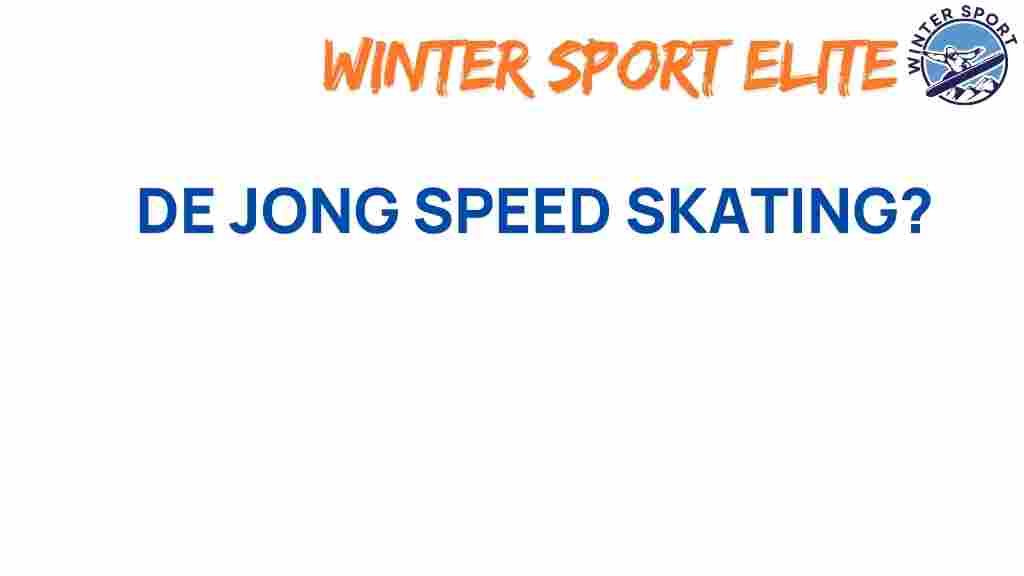The Art of Speed: What Makes De Jong a Skating Sensation?
In the world of winter sports, few athletes can claim the spotlight like De Jong. This remarkable speed skating sensation has captured the hearts of fans and the attention of competitors alike with his extraordinary performance and dedication. But what exactly sets De Jong apart from the rest of the pack? In this article, we will explore the various elements that contribute to his status as a premier athlete in the field of speed skating, including his impressive records, unique technique, rigorous training regimen, and the competitive landscape he navigates.
De Jong’s Journey to Speed Skating Stardom
De Jong’s journey to becoming a world-class speed skating athlete began at a young age. Hailing from a region known for its cold winters and extensive ice rinks, he was introduced to the sport early on. Here are some key milestones in his career:
- Early Beginnings: De Jong started skating at the age of six, quickly showcasing his natural talent.
- Junior Championships: He won several junior competitions, which helped build his confidence and skills.
- National Recognition: By his teenage years, he was a recognized name in national speed skating circles.
- International Competitions: De Jong began to compete on the international stage, consistently breaking records and earning medals.
The Training Regimen that Fuels Performance
To excel in competition, De Jong follows a demanding training regimen that emphasizes both physical and mental preparation. Here’s a closer look at how he trains:
- Endurance Training: De Jong focuses on long-distance skating sessions to build stamina.
- Speed Workouts: High-intensity interval training helps him improve his acceleration and top speed.
- Strength Conditioning: Weight training is crucial for developing the muscle power needed for explosive starts.
- Technique Drills: De Jong spends significant time refining his skating technique, ensuring optimal efficiency and balance.
- Recovery: Adequate rest and recovery strategies, including physiotherapy and nutrition, are integral to his routine.
Technique: The Secret to De Jong’s Speed
The art of speed skating is not solely about raw power; it’s also about technique. De Jong’s skating style incorporates several key elements that enhance his performance:
- Body Position: Maintaining a low center of gravity allows him to maximize speed while minimizing wind resistance.
- Stride Length: De Jong has mastered the art of long, powerful strides that propel him forward efficiently.
- Blade Control: His ability to control his skate blades on the ice is a testament to years of practice and experience.
- Transition Skills: De Jong excels at transitioning between different speeds and turns, a critical skill in races.
Records and Achievements
Throughout his career, De Jong has shattered numerous speed skating records and garnered accolades that reflect his status as an elite athlete. Some of his notable achievements include:
- World Record Holder: De Jong holds multiple world records in various distance categories.
- Championship Medals: He has won gold medals at World Championships and Olympic Games.
- National Titles: De Jong has consistently claimed the title of national champion in his home country.
Competition Landscape: Facing the Best
Competing at the highest level means facing off against some of the best athletes in the world. De Jong’s approach to competition is strategic and focused:
- Analyzing Competitors: He studies his opponents’ strengths and weaknesses to devise effective race strategies.
- Mental Preparation: De Jong engages in mental conditioning to maintain focus and composure during high-pressure races.
- Race Tactics: He employs various tactics, such as pacing and positioning, to optimize his chances of victory.
Troubleshooting Common Speed Skating Challenges
Even the best athletes face challenges in their sport. Here are some common issues in speed skating and how De Jong addresses them:
1. Balance Problems
Skaters may struggle with maintaining balance, especially during turns. De Jong emphasizes core strength training and proper body alignment to improve stability.
2. Fatigue
Fatigue can hinder performance. De Jong combats this with a well-structured training schedule that balances intensity and recovery.
3. Technique Errors
Improper technique can lead to inefficiencies. Regular video analysis of his skating allows De Jong to identify and correct mistakes swiftly.
4. Mental Blocks
Competition pressure can lead to mental blocks. De Jong practices visualization techniques to enhance his mental resilience.
The Future of De Jong in Speed Skating
As one of the leading figures in the world of winter sports, De Jong’s future looks bright. With the upcoming competitions on the horizon, fans eagerly anticipate what he will achieve next. His commitment to training, focus on technique, and competitive spirit are sure to propel him to even greater heights.
For those interested in following De Jong’s journey or learning more about speed skating, you can find additional resources at US Speedskating.
Conclusion
In conclusion, De Jong’s rise as a speed skating sensation is a result of meticulous training, exceptional technique, and an unwavering competitive spirit. His numerous records and accolades speak volumes about his dedication to the sport. As winter sports enthusiasts continue to watch and support athletes like De Jong, it is clear that the art of speed skating will thrive for years to come. Whether you’re an aspiring athlete or a fan of the sport, there is much to learn from De Jong’s journey and the passion he brings to the ice.
For more insights on speed skating techniques and training, check out our detailed guide here.
This article is in the category Events and created by WinterSportElite Team
